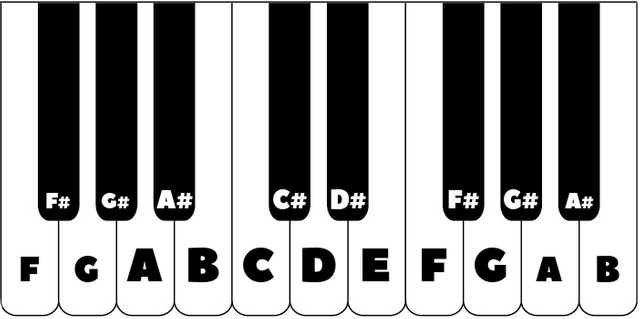Fast Music Theory: 12 tones
This post marks the beginning of the episodic release of my book Fast Music Theory: Understanding the Language of Music in Record Time. For my intro and the reason behind this project, check out my introduction post. Thank you Steemit Community for your input. Follow me to unlock the simple patterns behind these organized vibrations we enjoy every day.

CHAPTER ONE
12 Tones
“I know that the twelve notes in each octave and the variety of rhythm offer me opportunities that all of human genius will never exhaust.”
Despite all of the notes you hear on a daily basis, modern music is typically made up of only 12 different notes repeated in higher and lower variations. These notes are now your friends, so let’s get to know them.
Naturals
We’ll use a section of the piano because it has the most intuitive layout. Our white keys are represented by letters A-G. To the right are higher notes, and to the left are lower notes. Notice the white keys’ relationship to the black keys, alternating in twos and threes. Take a minute to memorize these notes.

MEMORIZATION TIP: You can pick two notes that are more obvious to you and memorize those first. I like C and F, notes to the left of black key groups. You can always alphabet your way to the other notes from those starting points.
LANGUAGE TIP: The word “note” is a very general term used in many different situations. When referring to the highness or lowness of a note, we sometimes use the term pitch. Notes are the landmarks that we’ve culturally chosen on an infinite scale of pitch.
Sharps and Flats
In music, sharp (#) is used to indicate a higher pitch, and flat (♭) is used to
indicate a lower pitch. The black keys are smaller and named after their relationship to the white keys they are next to: A# basically means “higher than A.” Here are the sharps.

Every black key has a second identity (we learn why in chapter 5: The Circle of Fifths). Here are those same notes with their alternate names. B♭ means “lower than B.”

If you keep moving to the right, you get a new A and the cycle continues in a new and higher octave. If you go left, you get a new G and access to lower octaves. Once you get used to the fact that A and G are next to each other, the toughest part is over.

MEMORIZATION TIP: Approach a piano or download a free piano app (Virtuoso Piano Free 3 HD for iOS users and Perfect Piano for Android) and try to hit every A on the piano. Do this with all of the notes. You’ll have it down in no time!
Though we are using a piano to learn these notes, keep in mind that most instruments play these notes as well. These 12 tones are universal throughout the musical world.
MEMORIZATION TIP: We are so used to the order of our English alphabet that it’s initially difficult to think about it in reverse. Practice saying or thinking the alphabet backwards from G to A. These letters will begin to take on new meaning soon enough!
Easy beginnings, huh? We'll use these notes to start building patterns and musical structures. Remember, you don't need to play music to understand these principles. Plenty of people love to appreciate music in a deeper way the same way they like to know what ingredients go into their favorite dishes.
Have a music theory question? You can always drop one here.
Was this easy to understand? If not, let me know so I can make the language clearer. Follow me for Chapter 2: Rhythm. Thanks, Steemit!

Congratulations @soundreasoning! You have completed some achievement on Steemit and have been rewarded with new badge(s) :
Click on any badge to view your own Board of Honnor on SteemitBoard.
For more information about SteemitBoard, click here
If you no longer want to receive notifications, reply to this comment with the word
STOPBy upvoting this notification, you can help all Steemit users. Learn how here!
Very cool! Followed you, I was a Theory/Composition major back in college
Great write up. Thank you.

HEYYY!! Nice article. Excellent writing and a super fun way to learn about music theory!
Very good post! Learning music is complicated if yo don't have the best teacher!